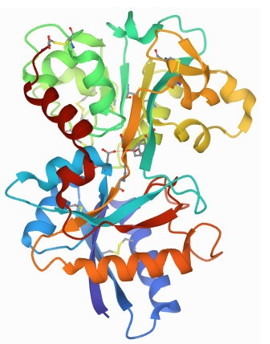Creative Biolabs provides the high affinity and diversity trans-body (hTF) library construction service by our Hi-Affi™ platform. This novel platform is based on trimer codon technology and NNK method, which can achieve over 1010 diversity and 100% precise mutant of the constructed library at lower cost compared with traditional methods.
Trans-body, referred to human serum transferrin (hTF), is a transport protein in the human blood. In total serum proteins, it occupies approx. 5-10% of the proportion, which is one of the most common serum molecules. Trans-body belongs to a group of iron-binding blood plasma glycoproteins which can tightly but reversibly bind to iron ions with high affinity and take responsible for controlling the level of free iron in biological fluids. This monomeric glycoprotein has a molecular mass of about 80 kDa and contains two binding sites specific for iron ions in the ferric form (Fe3+). The protein structure of trans-body is composed of two domains formed by α helices and β sheets, the iron-binding sites are located between two globular lobes which represent the N- and C- terminal sequences, respectively. Besides that, trans-body has a long circulatory half-life, a very important intrinsic property suitable for therapeutic peptide drug carrier.
According to these features, trans-body scaffold is able to be used as a carrier protein for insertion of functional peptide domains into its structure permissible surface loop in protein engineering, devoid of structural and physiological function influence. In addition, the interaction of transferrin and its receptor have been shown to diminish tumor cells, which the trans-body scaffold can be engineered to deliver or carry toxic agents to tumor cells as cancer therapy. It is also available to apply trans-body as a non-viral gene therapy vector to vehicle to deliver DNA to cells. Furthermore, the trans-body scaffold can attenuate the antigen-introduced peptide immune response in human. For all these characters, which are advantageous for developing a novel class of therapeutic agents, trans-body scaffold is potential to be a new tool for the treatment of a broad spectrum of diseases.
Scientists of Creative Biolabs generate the trans-body scaffold libraries through our proprietary Hi-Affi™ platform. This platform is an advanced phage display technology, which provides high affinity library by introducing random mutation sites with trimer codon technology and NNK method. For Hi-Affi™ phage display platform, the interest gene is fused to bacteriophage coat proteins and thereby displayed on the phage surface for screening and selecting of a broad range of target epitopes. Besides that, phage display method is a simple, easy enrichment of high affinity binder, which greatly reducing the workload of subsequent library screening.
Scientists from Creative Biolabs have years of experience in the field of scaffold libraries design and construction. The company has cooperated with most of academic, government and commercial labs throughout the world for a long period. Our expert scientists are confident in providing our global customers with high quality scaffold libraries that have the desired diversity and operability.

Fig. 1 Human serum transferrin. (PDB ID:1D3K)
All listed services and products are For Research Use Only. Do Not use in any diagnostic or therapeutic applications.